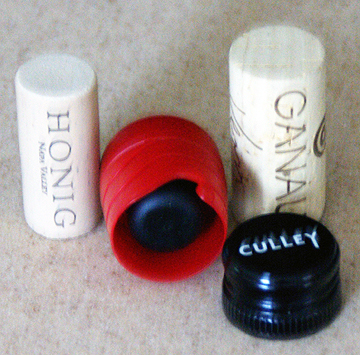Closures
by Terry Sullivan
I once met a couple at a restaurant wine tasting who were divided on the issue of screwcaps. The wife refused to drink a wine that had a screwcap closure. Her main objection was that screwcaps were not romantic. Her husband decided to continue to purchase wines with screwcaps. After removing the screwcap he put a cork in the bottle, and pulled it out while his wife watched from a distance. He poured the wine in a glass and both enjoyed it.
 Other people also feel that screwcaps are not romantic. Neither are corked wines. Screwcaps do have their positive points and supporters. These bottles are easy to open and one doesn’t need a corkscrew to open the bottle, although this has been tried - often to the dismay of ruining the corkscrew. What is new about wine bottle closures?
Other people also feel that screwcaps are not romantic. Neither are corked wines. Screwcaps do have their positive points and supporters. These bottles are easy to open and one doesn’t need a corkscrew to open the bottle, although this has been tried - often to the dismay of ruining the corkscrew. What is new about wine bottle closures?
Synthetic closures are till popular with some winemakers. Nomacorc produces a consistant closure that has a foamed core inside and an outer skin. The core is breathable and allows for oxygen to transfer through the closure at optimum rates. The outer skin creates a consistant seal and resembles natural cork. When extracted one will hear the “pop” sound associated with romance. Nomacorc makes different types of closures for different types of wine. Each type of closure has a different oxygen transfer rate. Synthetic closures became increasing popular when cork closures were experiencing a downward trend in usage.
However the cork industry has seen a tremendous push toward quality control over the past few years and is making a comeback. Phil Durrett of ACI Cork USA explained at the Wineries Unlimited Trade Show in surbaban Philadelphia that the cork industry has put a lot of money toward researching TCA, 2,4,6-Trichloroanisole, responsible for the cork taint in wines. The industry is using better techniques while harvesting cork, often harvesting the cork from trees higher off the ground where there is less chance of TCA. Cork manufacturing plants are bleaching the cork using a peroxide solution rather than a chlorine based solution. It was discovered that chlorophenols, a result of chlorine bleaching, led to higher occurrences of TCA. Many people hold on to traditions and using cork as a wine bottle closure is certainly a tradition. With the industry’s emphasis on quality there will be fewer bottles with cork taint and fewer bottles with leakage.
A newer product discovered at Wineries Unlimited was the Zork. From a distance it appears as though the bottle has a wax closure. Upon closer observation, one will notice that the closure is plastic. At the bottom of the outside of the closure there is a tab that you simply peel off. You can then remove the closure and hear the “pop” sound. The Zork product has the advantage of a screwcap with its ease to remove. It makes the romantic pop sound. The closure can simply be placed back onto the bottle after pouring the wine. This is a very easy to use closure that doesn’t require a corkscrew to remove it. Whether it catches on with more wineries using it will depend on how consumers react to the closure.
